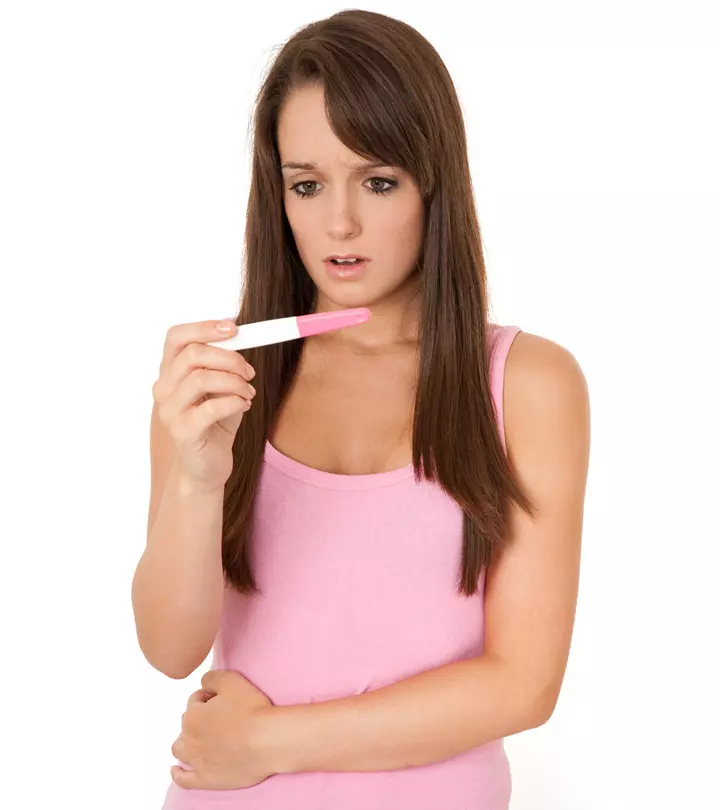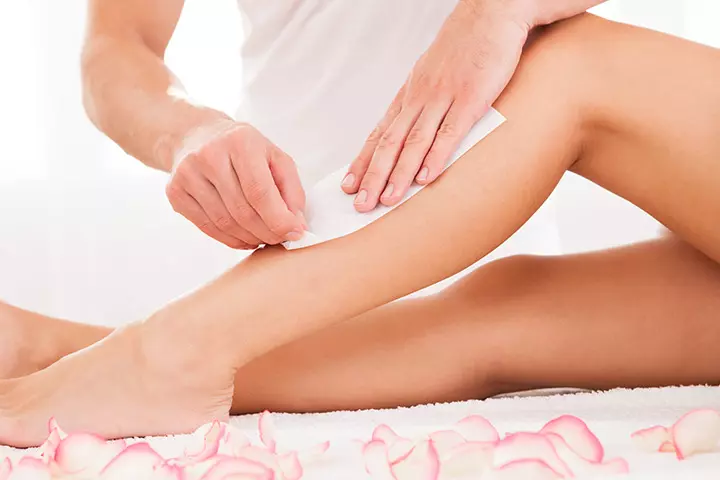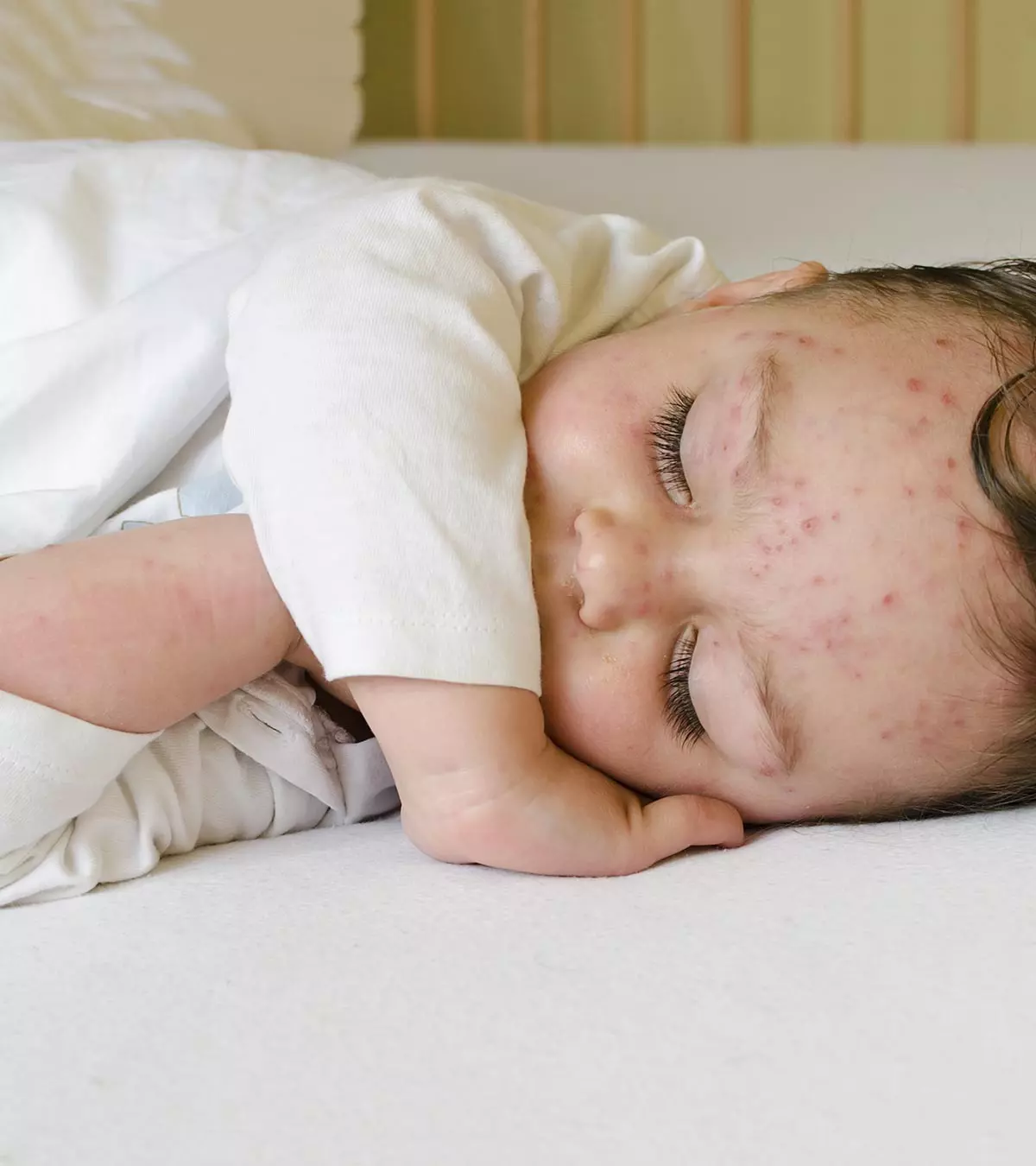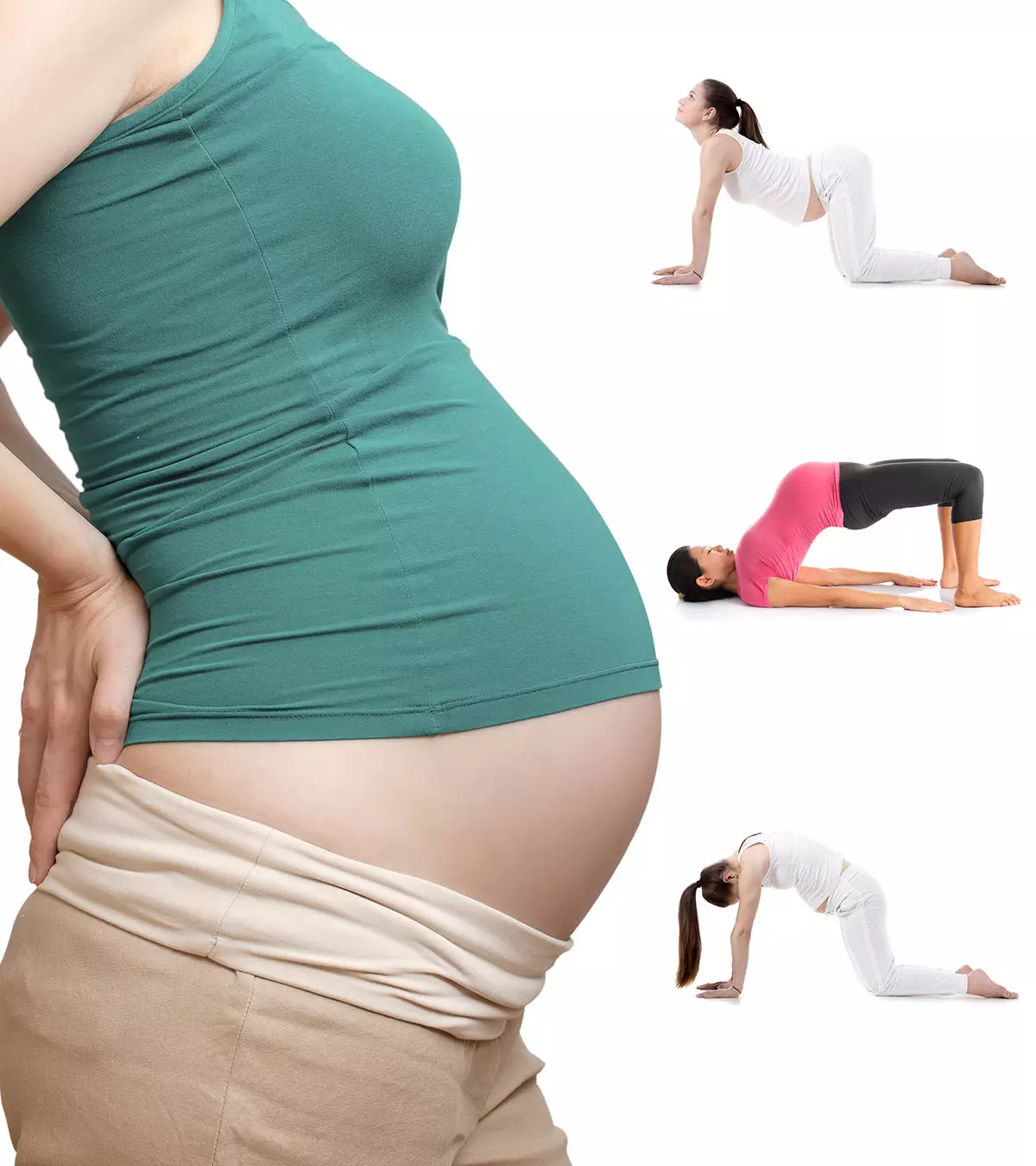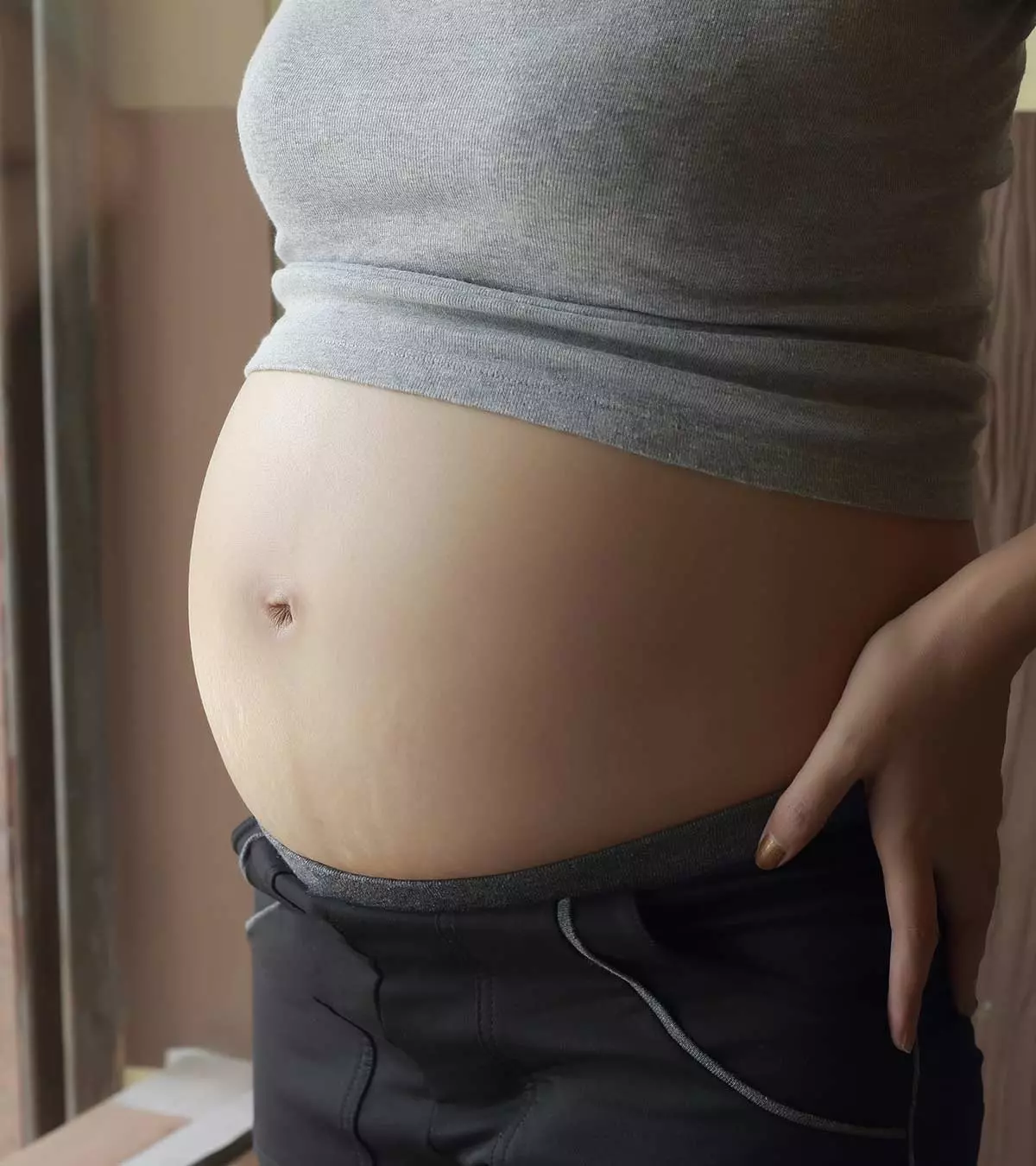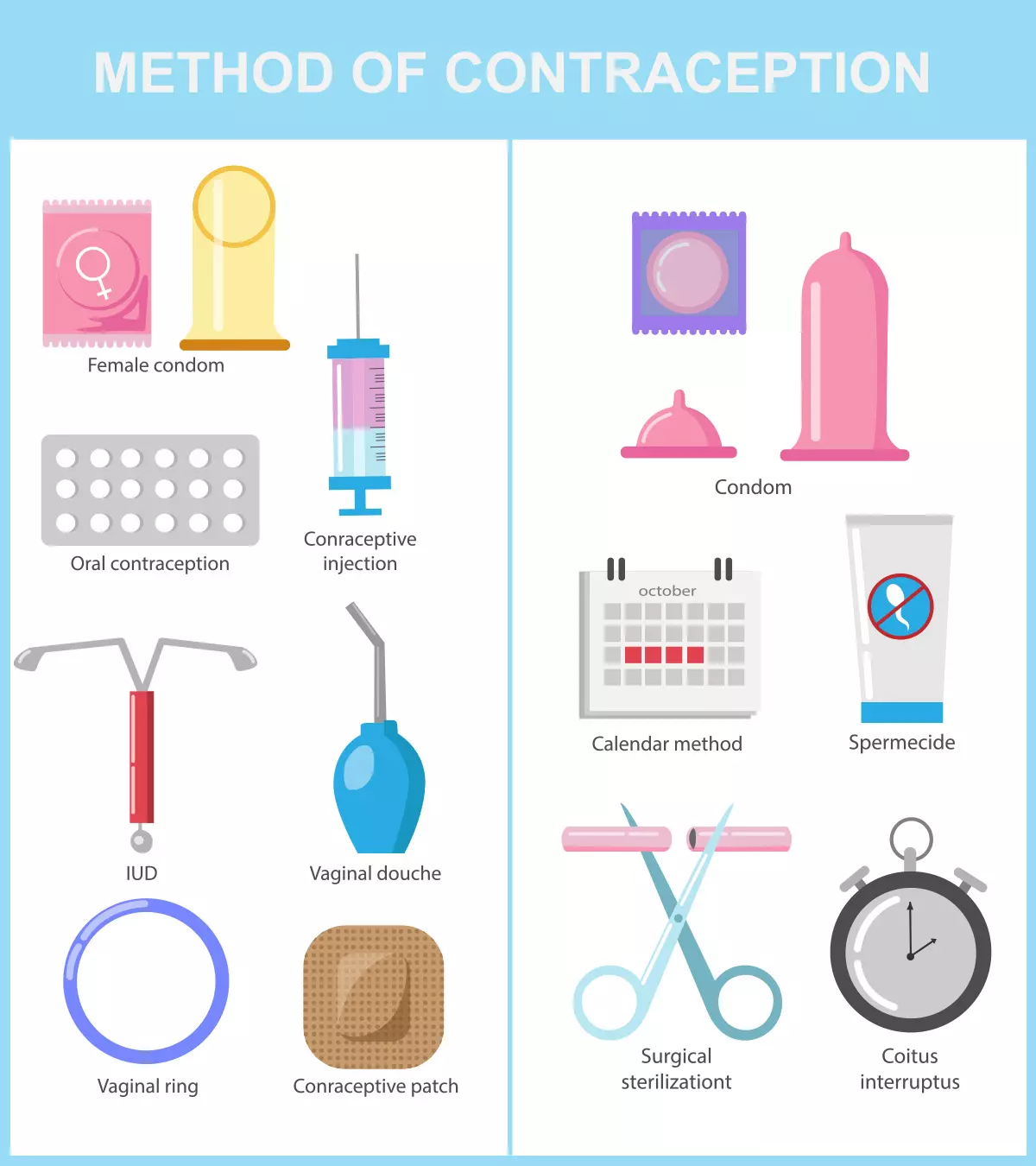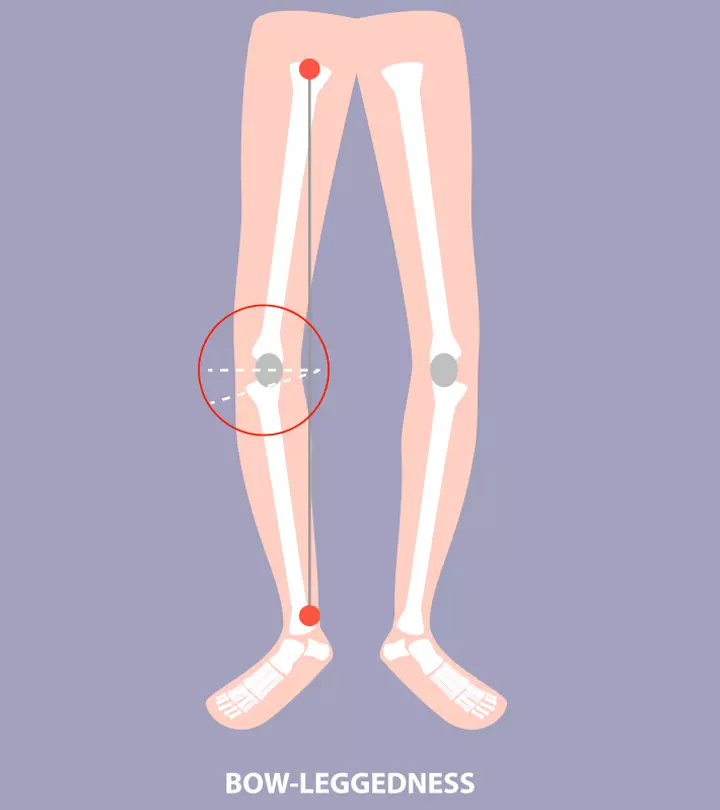
Image: iStock
Bowed legs in babies is a condition where their lower legs have an outward curve, and their knees stay apart. It may seem unusual to parents; however, the condition is normal in infants. As the baby grows and starts walking, their legs straighten, and the bowlegs resolve. However, the curve either remains or worsens in some children, indicating a health problem. Children may develop bowlegs due to several reasons, such as rickets, fractures, or obesity. If you notice this condition in your children, consult a doctor for a proper diagnosis and treat them as soon as possible. Read the post to understand more about bowed legs in babies, including its causes, diagnosis, treatment, and prevention techniques.

Key Pointers
- Bowlegs or legs with an outward curve are a normal occurrence in babies and typically correct themselves as the baby begins walking.
- However, persistent bowed legs may be due to underlying medical conditions such as Blount’s disease, dwarfism, obesity, or injuries.
- Treatment options can vary from vitamin supplements, physiotherapy, and leg braces to surgery in severe cases.
- Adequate nutrition and vitamin D levels, and providing lead or fluoride free drinking water, may help prevent bowed legs.
- If the condition persists beyond the age of three years, it may indicate an underlying medical condition that requires medical intervention.
What Are Bowlegs?
Bowlegs, also known as congenital genu varum, is a condition where the infant’s legs bend outwards, forming a curve that resembles a bow (1). Observe the legs when the baby stands. If the feet stay together, but the knees do not meet, and the lower leg bends outwards, then the baby is known to be a bow-legged baby. Bowlegs could also be visible when you stretch the baby’s legs straight during a massage. Bowing could happen on both legs or just one leg (2). Bowlegs may also be a symptom of another congenital bone disorder called Osteogenesis imperfecta or Chronic hypophosphatemia (3) (4).
Are Bowlegs Normal?
Most infants have bowlegs due to their curled-up position in their mother’s womb (5). This congenital skeletal anomaly usually resolves once the baby starts balancing while walking. Hence bowlegs are considered normal in babies under 18 months of age (6).
Even in younger children, bow legs usually do not cause any pain or discomfort. While you may worry about your child’s walking pattern or appearance of legs, it usually does not affect their crawl, walk, or run. If the condition does not resolve by three to four years of age and is associated with pain, swelling, or difficulty walking, then a pediatric consultation is warranted (7). An underlying health condition could be a reason for unresolved bowlegs by three years of age (8).
 Did you know?
Did you know?What Are The Causes Of Bowlegs?
Sometimes, bowlegs could be a result of a skeletal deformity or anomaly, due to a health problem or nutritional deficiencies. A baby’s bowlegs can persist beyond the age of three years due to the following reasons (9) (10):
- Infantile Blount’s disease: Also known as tibia vara, Blount’s disease is a condition where the baby develops an abnormality in the growth plate right above the tibia bone, which is the larger of the two bones in the lower leg. This disease causes the outer side of the bone to grow at a healthy pace while the inner side grows slowly. It is a developmental abnormality that eventually causes bowed legs. Precocious walking, or walking at an early age, is a symptom of Blount’s disease and a cause for bowlegs.
- Rickets: Caused due to a deficiency of vitamin D, rickets is often associated with bowed legs, which is also one of the symptoms of the condition (11).
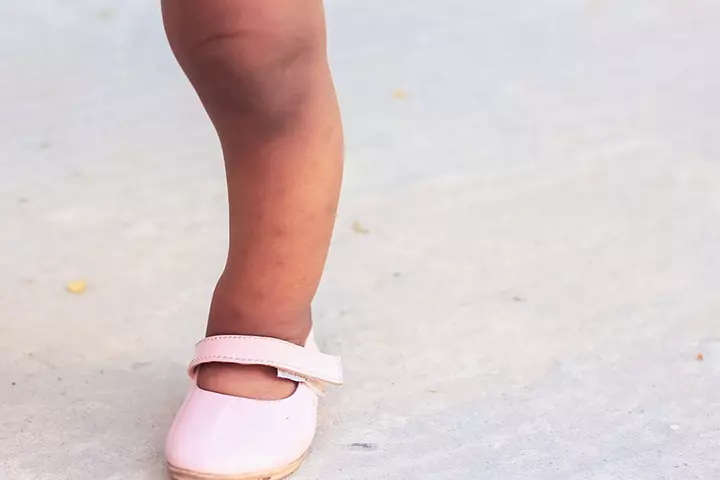
- Dwarfism: If the baby develops dwarfism, then the lower legs can be susceptible to bowing. Numerous reasons arising from genetic disorders can cause Dwarfism in children. Infants with dwarfism have problems converting the cartilage into bone, which leads to an abnormal limb growth and the development of bowlegs (12).
- Fractures: A fracture of the lower leg bone during infancy may result in improper bone healing, which can cause the lower leg to bow. The condition is medically called tibial pseudarthrosis (13).
- Fluoride or lead poisoning: Excess fluoride consumption and lead ingestion can interfere with bone growth and cause abnormalities like bowlegs (14) (15). The primary source of fluoride and lead is drinking water.
- Obesity: Obesity has been linked to the development of bowlegs (16). According to the World Health Organization (WHO), 39 million children under the age of five across the globe were found to be overweight or obese in 2025 (17). Toddlers who are fed junk food or given high-sugar beverages such as juices and soft drinks tend to become obese. The excess body weight can cause the soft, underdeveloped infantile legs to buckle under pressure and cause bowlegs.
 Quick fact
Quick fact
Orthopedic abnormalities, such as bow legs in infants, can be concerning for parents, but with proper evaluation and treatment, most cases can be successfully managed and ensure healthy development of their child’s bones and joints. A report by the American Academy of Pediatrics states, “It is entirely normal for a toddler just starting to walk to be “bowlegged” or “pigeon-toed,” or for a 3-year-old to have “knock-knees.” However, it may be pathologic for a 10-year-old to have significant genu valgus (knock-knees) or a 5-year-old to have severe genu varum (bowed legs) (19).” Your Pediatric orthopedics specialist will be able to identify the cause of prolonged bowlegs or other bone deformities during diagnosis.
How Are Bowlegs In Babies Diagnosed?

A doctor can diagnose bowlegs merely by visual inspection of the legs. Early diagnosis of bowlegs can help with timely intervention and better outcomes, preventing any potential complications. So,if the baby is more than three years old and still has bowlegs, then the doctor may perform a more comprehensive check through the following methods (20):
- Measuring the distance between the knees while the baby lies on his/her back. A greater distance can indicate abnormality and the presence of bowlegs.
- X-rays could help check for bone anomalies and problems in bone growth that could have led to bowlegs.
- Blood tests to check vitamin D deficiency, serum alkaline phosphatase level, or the presence of excess lead and fluoride in the blood.
The doctor will ask you to walk the baby for some distance. The assessment of the baby’s gait can reinforce the diagnosis. If the diagnosis confirms bowlegs due to an underlying medical condition, the baby would need treatment.
How Are Bowlegs In Babies Treated?
Normal bowlegs that are not caused by a problem go away by the age of three years. However, the ones caused by a medical condition would require correction. Early detection and appropriate management can help correct the condition effectively. Treatment of bowlegs in babies entirely depends on the fundamental cause and could include (21) (22):
- Leg braces: The doctor can recommend leg braces that the baby has to wear always or for a specific period depending on the severity of the curve. Braces are almost always the first choice of treatment since they are not invasive. Leg braces, ideally worn for a year and more, could be a stand-alone treatment or combined with operative procedures.
- Surgery: Bowlegs can be corrected by surgery, depending on what led to the formation of bowlegs. A procedure called osteotomy can fix the joints of the lower leg and align them properly. Other methods include bone grafting and insertion of an intramedullary rod along the bone in cases of bowlegs caused by fractures.
An orthopedic surgeon can best suggest the right procedure to correct the condition. In any case, surgery is best before the age of four years since the risk of relapse post-surgery increases after that.
- Vitamin D supplementation: Adequate vitamin D and calcium supplementation provide nutrients to the bone to correct itself. Bowlegs due to metabolic bone diseases like rickets could be cured by these supplements alone.
- Physiotherapy: Physical therapy and rehabilitation let your baby regain the correct walking style and pattern. This therapy is mostly used in conjunction with other treatment methods. The primary aim of physiotherapy is to restore normal joint movement and improve muscle strength.
A mother recounts the treatment plan recommended for her bow-legged son. She says, “We decided that it might be best to try braces along with exercises to see if we would get his legs to straighten out better. There are two reasons why is legs are bowed.. one is obviously the bone itself is bowed, but also, the muscles and ligaments are pulling at the bones which are keeping them bowed! The exercises help with the muscles and ligaments stretching, while the braces will help his bones straighten out (i).”
The surgeon may also use external fixators, which are metallic-circular devices worn over the affected leg. The fixator can be used after the surgery to help further align the legs and fix discrepancies in limb lengths.
As babies start to walk, the bowing might increase to some extent. If you notice, babies who start walking early may have more visible bowing. Sometimes, you could prevent bowlegs if they are traced promptly with accurate causative factors. Find out how next.
Can Parents Prevent Bowlegs In Babies?
You can prevent bow legs caused by injury, nutrient deficiency, and ingestion of hazardous elements such as lead and fluoride. Here are a few steps that can mitigate the chances of bowlegs in infants:
- Be mindful of injuries: Leg fractures during infancy increase the chances of bowlegs. Baby-proofing your home when your little one begins walking keeps the baby safe, and prevents the chances of injuries or fractures due to falling.
- Give the baby adequate vitamin D: Vitamin D aids in better absorption of calcium and phosphorus for healthy bone growth (23). The American Academy of Pediatrics recommends a daily dose of 400 IU (international units) of vitamin D per day for infants and toddlers (24). Formula-fed babies usually get the recommended dose from 32 oz (947 ml) of fortified formula per day, while exclusively breastfed babies can be given vitamin D supplements after doctor consultation.

- Prevent lead and fluoride poisoning: Make sure that the drinking water at your home is free of lead or fluoride. While lead is a definite no-no in drinking water, there may be some amount of natural fluoride in water supplied by local municipal bodies. Usually, less than 1 mg of fluoride in one liter of water is safe without adverse consequences (25).
What Are The Complications Of Bowlegs?
Bowlegs, if left untreated, could lead to complications in later life. Prominently it could cause difficulty in walking. The condition may lead to arthritis in the knees and hips (8).
Is Bowlegs Different From Knock Knees?
Yes. Knock knees are the opposite of bowlegs, where the lower legs bend inwards instead of outwards (21). A baby with knock knees can hold the knees together without bringing the feet close together. A baby with bowlegs can bring the feet together but will have a substantial gap between the knees.
 Quick fact
Quick factFrequently Asked Questions
1. Do bow legs get worse with age?
According to experts, bow legs get worse after three years of age and can be clearly seen in an x-ray (9). Thus, if your child’s bow leg doesn’t resolve by two years of age, speaking to a specialist is necessary.
2. Do diapers cause bowlegs?
Some people believe that diapers can cause bow legs in babies. A 2012 study showed that cloth diapers affect an infant’s walking (26). However, no other studies exist to validate these findings.
3. Do babies outgrow bow legs?
Bowed legs in babies are generally prevalent in infancy and the early stages of toddlerhood, and they can affect both or just one leg. Some children may have the condition until they are four or five years old, after which they will lose their bow shape. However, if left untreated, it can lead to leg difficulties later in life, such as trouble walking. Therefore, your doctor may advise treating your child with vitamin D supplements, leg braces, physiotherapy, and even surgery. If you observe any irregularities while straightening your baby’s leg, schedule an appointment with a doctor immediately.
Infographic: What Are The Causes Of Bowlegs?
Bowlegs is a condition typically seen in children but can also affect adults. The causes of bowlegs can vary and may include genetics, certain medical conditions, and dietary deficiencies. The infographic below sheds light on the different causes of bowlegs and the factors that increase the risk of this condition.
Some thing wrong with infographic shortcode. please verify shortcode syntax
Learn everything you need to know about bow legs in children from this video. Get the facts on causes, treatments, and prevention of bow legs in kids, and more.
Personal Experience: Source
MomJunction articles include first-hand experiences to provide you with better insights through real-life narratives. Here are the sources of personal accounts referenced in this article.
i. One in a Million.
https://thebowleggedcowboy.wordpress.com/2013/02/22/one-in-a-million/
References
- Bow-legged (Genu Varum).
https://www.cedars-sinai.org/health-library/diseases-and-conditions/b/bow-legged-genu-varum.html - Bowed Legs (Genu Varum).
https://www.childrenscolorado.org/conditions-and-advice/conditions-and-symptoms/conditions/bowed-legs/ - Osteogenesis Imperfecta.
https://www.hopkinsmedicine.org/health/conditions-and-diseases/osteogenesis-imperfecta - Hypophosphatemia.
https://my.clevelandclinic.org/health/diseases/24040-hypophosphatemia - Pediatric Bowlegs.
https://www.childrensnational.org/get-care/health-library/bowlegs - Bow Legged.
https://my.clevelandclinic.org/health/diseases/22049-bow-legged - Bow Legs (Genu Varum).
https://kidshealth.org/en/parents/bow-legs.html - Bowlegs.
https://medlineplus.gov/ency/article/001585.htm - Bowed Legs (Genu Varum Blount’s Disease).
https://orthoinfo.aaos.org/en/diseases–conditions/bowed-legs-blounts-disease - Bow Legs (Bow Legged).
https://www.nyp.org/pediatrics/orthopedics/bow-legs - Rickets.
https://www.rch.org.au/kidsinfo/fact_sheets/Rickets_Vitamin_D_deficiency/ - Dwarfism.
https://kidshealth.org/en/parents/dwarfism.html - Tibial Pseudarthrosis: Incorrect Healing After a Pediatric Fracture of the Lower Leg.
https://www.hss.edu/conditions_tibial-pseudarthrosis-overview.asp - Navneet Singh et.al; (2014); A comparative study of fluoride ingestion levels serum thyroid hormone & TSH level derangements dental fluorosis status among school children from endemic and non-endemic fluorosis areas.
https://pmc.ncbi.nlm.nih.gov/articles/PMC3890436/ - Ramin Espandar et.al; (2010); Angular Deformities of the Lower Limb in Children.
https://pmc.ncbi.nlm.nih.gov/articles/PMC3289162/ - Limb (Leg) Deformity Reconstruction for the Pediatric Patient.
https://www.hss.edu/conditions_limb-leg-deformity-pediatric-patient.asp - Obesity and overweight.
https://www.who.int/news-room/fact-sheets/detail/obesity-and-overweight - Complications -Paget’s disease of bone.
https://www.nhs.uk/conditions/pagets-disease-bone/complications/ - Foot and Leg Problems.
https://publications.aap.org/pediatriccare/book/348/chapter-abstract/5772647/Foot-and-Leg-Problems-Chapter-154?redirectedFrom=fulltext - Blount’s Disease: An Overview.
https://www.hss.edu/conditions_blounts-disease-overview.asp - Bowlegs.
https://www.childrenshospital.org/conditions/bowlegs - Vitamin D Deficiency and Rickets.
https://www.healthychildren.org/English/healthy-living/nutrition/Pages/Vitamin-D-Deficiency-and-Rickets.aspx - Where We Stand: Vitamin D & Iron Supplements for Babies.
https://www.healthychildren.org/English/ages-stages/baby/feeding-nutrition/Pages/Vitamin-Iron-Supplements.aspx - Ene Indermitte et.al; (2009); Exposure to High Fluoride Drinking Water and Risk of Dental Fluorosis in Estonia.
https://pmc.ncbi.nlm.nih.gov/articles/PMC2672351/ - What is knock knees?
https://www.childrenshospital.org/conditions/knock-knees - Whitney G Cole et.al; (2012); Go Naked: Diapers Affect Infant Walking.
https://pmc.ncbi.nlm.nih.gov/articles/PMC3580949/
Community Experiences
Join the conversation and become a part of our nurturing community! Share your stories, experiences, and insights to connect with fellow parents.
Read full bio of Dr. Surabhi Gupta
Read full bio of Rohit Garoo
Read full bio of Dr. Ritika Shah
Read full bio of Vidya Tadapatri







